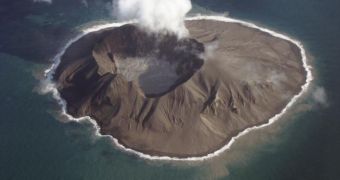In one of the first such instances ever, scientists are now conducting studies into determining how animal life and vegetation recovers on a small island, after being subjected to catastrophic volcanic eruption.
At first, it appeared as if the event had wiped out all living things on the island, but now researchers say that they are unsure whether that was actually the case.
They are now surveying the area, keeping an eye on how ecosystems on land and in the nearby ocean survive, adapt and evolve. The work could have significant implications for understanding how Earth recovered after massive extinction events.
The Kasatochi Island was never really studied before August 7, 2008. This is when a massive volcanic eruption took place here, wiping out all living things, and covering the land in lava.
Now, as researchers investigate the area, they keep finding small patches of grass, some winged beetles, as well as other creatures, spread out all over the place.
Though finding living creatures of vegetation is still a challenge on the island, scientists are convinced that life will make a full recovery on the island. This is remarkable, considering that the disastrous event took place only two years ago.
The Kasatochi Island is located in the Alaska Maritime National Wildlife Refuge, experts at the United States Geological Survey (USGS) say.
Researchers here are collaborating with colleagues from the US Fish and Wildlife Service (FWS), and the University of Alaska Museum of the North in tracking how life returns to the charred island.
“When we first landed on the island, we were unsure of what we would find. The formerly lush, green island was uniformly gray and in the 10 months since the eruption, considerable erosion of volcanic ash had occurred,” says USGS project manager Tony DeGange.
“We are now in the midst of our second year of research at Kasatochi Island, and our intent is to continue this work for many years,” the expert adds.
“The Aleutian Islands are a part of the Pacific Ring of Fire, and destructive volcanic eruptions are a primary form of ecosystem disturbance in these earthquake- and volcano-prone zones that reach from Chile up to Alaska and down through the South Pacific,” he says further.
“Kasatochi Island is a natural laboratory that will help us understand how volcanic eruptions shape Aleutian Island ecosystems,” DeGange concludes.

 14 DAY TRIAL //
14 DAY TRIAL //